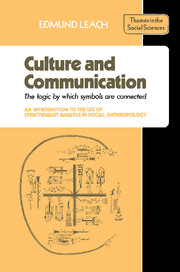 Culture and Communication
Culture and Communication Book contents
- Frontmatter
- Contents
- Culture and communication: the logic by which symbols are connected
- Introduction
- 1 Empiricists and rationalists: economic transactions and acts of communication
- 2 Problems of terminology
- 3 Objects, sense-images, concepts
- 4 Signals and indices
- 5 Transformations
- 6 Theories of magic and sorcery
- 7 The symbolic ordering of a man-made world: boundaries of social space and time
- 8 The material representation of abstract ideas: ritual condensation
- 9 Orchestral performance as a metaphor for ritual sequence
- 10 The physiological basis of sign/symbol sets
- 11 Mapping: time and space as reciprocal representations
- 12 Rank order and orientation
- 13 Examples of binary coding
- 14 Mating prescriptions and proscriptions
- 15 Logic and mytho-logic
- 16 Basic cosmology
- 17 Rites of transition (rites de passage)
- 18 The logic of sacrifice
- 19 Conclusion
- Bibliography
- Index
- Frontmatter
- Contents
- Culture and communication: the logic by which symbols are connected
- Introduction
- 1 Empiricists and rationalists: economic transactions and acts of communication
- 2 Problems of terminology
- 3 Objects, sense-images, concepts
- 4 Signals and indices
- 5 Transformations
- 6 Theories of magic and sorcery
- 7 The symbolic ordering of a man-made world: boundaries of social space and time
- 8 The material representation of abstract ideas: ritual condensation
- 9 Orchestral performance as a metaphor for ritual sequence
- 10 The physiological basis of sign/symbol sets
- 11 Mapping: time and space as reciprocal representations
- 12 Rank order and orientation
- 13 Examples of binary coding
- 14 Mating prescriptions and proscriptions
- 15 Logic and mytho-logic
- 16 Basic cosmology
- 17 Rites of transition (rites de passage)
- 18 The logic of sacrifice
- 19 Conclusion
- Bibliography
- Index
Summary
Before I go further I need to elaborate somewhat the very brief distinction which I have already made between a signal and an index (above, p. 12). You should again keep a watch on Fig. 1 (p. 12).
Signal refers to any automatic trigger response mechanism. In nature, most signals are biological. Every natural species has become adapted by evolution to respond to its environment by a complex mesh of signals. To take a simple human example. If I do not drink for several hours on a hot day I become thirsty. ‘Feeling thirsty’ is a biological signal which triggers off a response. I look for something to drink.
The extent to which communication between adult human individuals is governed by true signals is not at all clear, but a mother's responses to the cries and smiles of her infant are certainly largely ‘instinctive’, and we do not shed our animal nature as we get older.
Two general characteristics of signals deserve particular attention:
A signal is always part of a cause and effect sequence. It is first generated by a prior cause and then functions as a cause to generate a later effect.
There is always a time lag between a signal and its consequence.
Human technical actions which alter the physical state of the world out-there (p. 9) closely resemble signals in this respect. The principal difference is that signals are ‘automatic’ in that they do not entail an intentional response on the part of the receiver, but they are not fully mechanical in that the effectiveness of the signal depends upon the sense response of the receiver which is not fully predictable.
- Type
- Chapter
- Information
- Culture and CommunicationThe Logic by which Symbols Are Connected. An Introduction to the Use of Structuralist Analysis in Social Anthropology, pp. 23 - 24Publisher: Cambridge University PressPrint publication year: 1976


